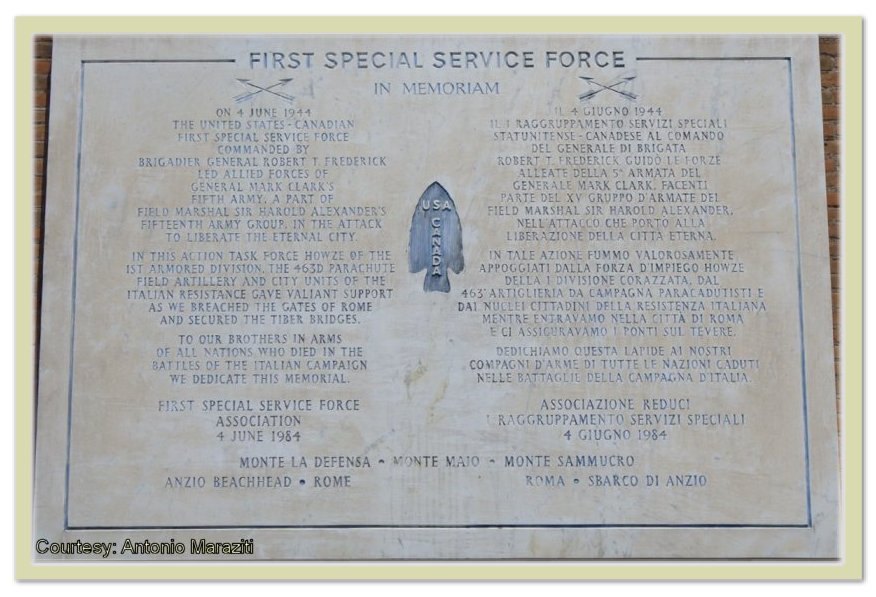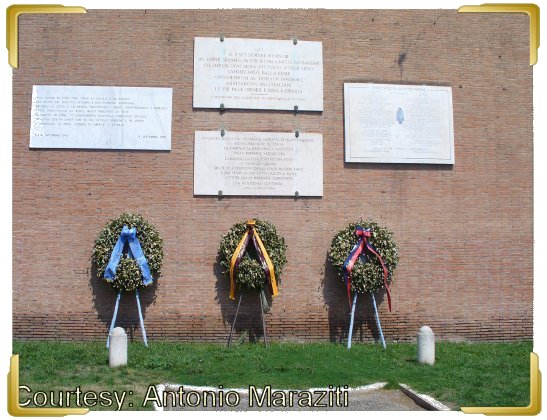|
The ITALIAN CAMPAIGN
Introduction
456th/463rd Parachute Field Artillery
Battalions
(Thank you Mr. Ken Hesler for the writing and Mr.
Stuart Seaton for reviewing)
When Italy was invaded by Allied Forces on September 3, 1943, the
463rd Parachute Field Artillery Battalion did not exist. As a
military unit, it never went overseas or returned to the States
after World War II, being inactivated in Joigny, France, November
30, 1945. Yet, a majority of its soldiers served with the two
premier airborne divisions of World War II; fought in seven major
campaigns, including two airborne invasions; provided, as a separate
battalion, artillery support for elite infantry and commando units;
and earned a place in the military annals of World War II for it
accomplishments.
All of this began when the 456th Parachute Field Artillery
Battalion was activated in 1942 as the first parachute field
artillery unit staffed largely with officers and men from the
Parachute Test Battery that had developed a system of delivering
75mm howitzers to the battlefield by air. As part of Gen. Matthew B.
Ridgeway’s 82nd Airborne Division, it participated in the July 1943
invasion of Sicily.
At the conclusion of that campaign in August 1943, circumstances
intervened. First, Ridgeway’s 82nd Airborne Division, including the
456th, was assigned to Gen. Mark Clark’s Fifth Army, resulting in a
disagreement between Ridgeway and Clark as to the final disposition
of the Division’s forces. The 82nd was already slated for the
Normandy invasion in 1944, but Clark sought the Division for use by
his Fifth Army in Italy.
According to Clay Blair, author of “Ridgeway’s Paratroopers”, the
conflict between Ridgeway and Clark “led to prolonged discussions at
the highest levels in North Africa, London and Washington, which
resulted in a compromise”.
Ridgeway’s 504th Parachute Infantry
regiment, the 376th PFAB, and the 456th, would remain for an
indefinite period under Clark’s command. The remainder of the 82nd
would be transferred to the British Isles. By the end of September
1943, the first two were already in Italy, leaving the 456th to
shuttle back and forth between Sicily and North Africa for training
exercises after not being included in the 82nd’s invasion plans for
Salerno.
According to a report presented to the Army Command and General
Staff College at Fort Leavenworth, KS, in 2004, "The reason for not
taking the 456th into combat on Salerno was due to an altercation
between the division commander and the 456th battalion commander in
one of the battles at Sicily… It came down to a difference in
artillery philosophy between Ridgeway and Lt. Col. Harrison B.
Harden, the 456th battalion commander". The result was Harden being
relieved and replaced by Maj. Hugh A. Neal, who would command that
unit until being seriously wounded at Anzio May 31, 1944.
After the war, Neal recalled that “Harden, Taylor, and Ridgeway
had been at odds. Why? I am not sure that I know. But the feeling
was not good at all”. Neal speculated "that Ridgeway, through Gen.
Maxwell Taylor, his artillery commander, had simply used that
opportunity to cut the battalion in two and get rid of Harden at the
same time."
In mid-November 1943, the First Special Service Force, the “Devils
Brigade,” a joint American-Canadian commando unit, arrived in Naples
and was assigned to the 36th Infantry Division along the Cassino
front. About five weeks later, the 456th,"less Batteries C and D,
shipped from Bizerte, Tunisia, (arriving through the Port of Naples)
and went into position near Ceppagna, Italy, in support of the
Force", according to Lt. Col. John T. Cooper who had succeeded Maj.
Neal as commanding officer.
Doug Bailey of “B” Battery, 456th, describes the Italian venture
this way in his “Condensed and Unofficial History of the 463rd
Parachute Battalion”:
"Landing at Naples (November 30, 1943), we
marched to Bagnolia and then on to Santa Maria where we joined
forces with the U.S. and Canadian First Special Service Force.
Within a week we were up on the Cassino front. This was in December
1943, and we spent Christmas at the front up around Venafro. Little
did we realize that a year later we would be spending another
Christmas in the snows of Bastogne. Rain, snow, mud, mules and mountains - that's the story of the
Cassino front. The only place during the whole war that the ground
looked like pictures of No-man's land during the First World War
with water filled shell holes, shattered trees and destroyed
villages.”
Lt. Col. Robert D. Burhans in his book, “The First Special Service
Force: A War History of the North Americans, 1942-1944”, notes the
arrival of the 456th in Italy: “They were new to the Force then but
would in the coming months become as closely attached in common
experience as artillery could manage with infantry”. That close
relationship of the 463rd and the Devils Brigade on Anzio would
continue at Anzio and in Southern France . The FSSF was deactivated
December 5, 1944.
Pictures beneath come from LTC R.
Burhans's Book.
Referencing the ISBN number of
“The First Special Service Force: A War History of the North
Americans, 1942-44”
by Lieutenant Colonel Robert D. Burhans,
published first in 1947 by the Infantry Journal Press
and reprinted by The Battery Press, Nashville, TN, in 1996,
it is ISBN 0-89839-261-6.
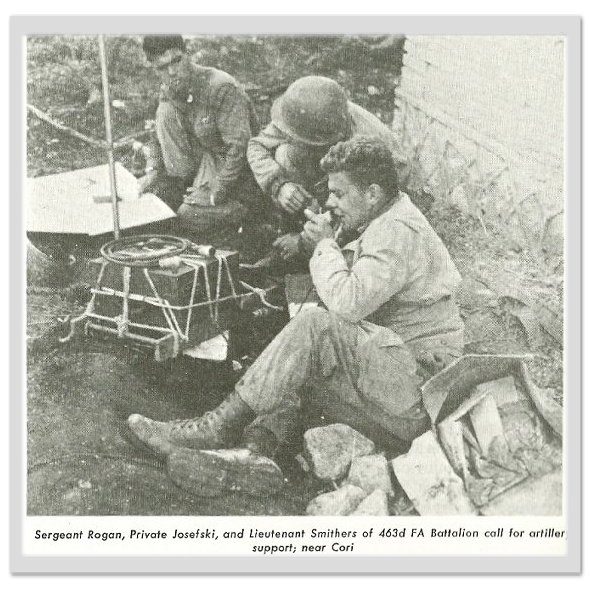
LTC R. Burhans's Book, page 218.
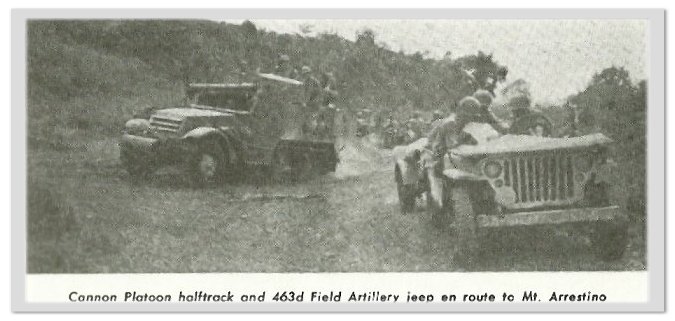
LTC R. Burhans's Book, page 217.
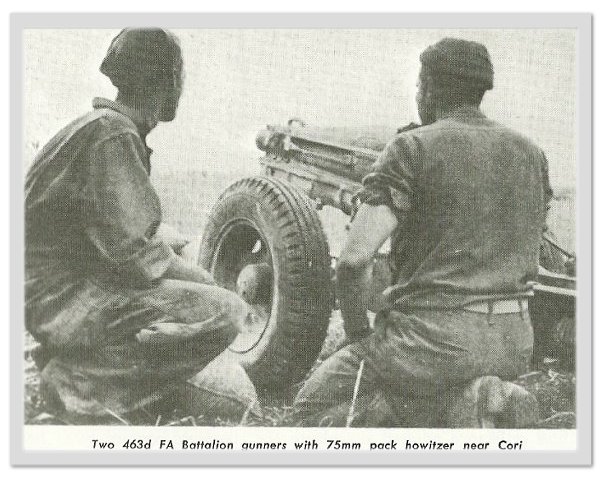
LTC R. Burhans's Book, page 223.
The 456th and the Force loaded on naval landing crafts near
Naples at the ancient port city of Pozzuoli on January 31 and
departed for the Anzio beachhead, landing the next day without
incident. On February 2, both went into positions on the beachhead.
Burhans writes: “The Corps orders read: ‘First Special Service, with
456th Field Artillery Battalion (less Batteries C and D) attached,
will relieve the 39th Engineer Combat Regiment night 2-3 February
and defend right flank of VI Corps S of (Bridge 5)…' The Force had been
fortunate in obtaining the attachment of the 456th Field Artillery
Battalion which was also in support”. (Bridge 5 refers to a bridge
across the Mussolini Canal and the right flank of VI Corps S that
was along the Mussolini Canal.) As noted on the FSSF memorial in
Rome, the men of the 456th/463rd and the Force would cross the
bridges of the Eternal City together when that city fell on June 3,
1944.
At 1 p.m. February 20, 1944, on the Anzio Beachhead, 336 officers
and men of the 456th Parachute Field Artillery Battalion were
officially constituted as the 463rd Parachute Field Artillery
Battalion that was activated on that date. The detached batteries (C
and D) of the 456th would be reconstituted in the British Isles as
the 456th Parachute Artillery Battalion. In late March 1944, the
504th Parachute Infantry Regiment and the 376th Parachute Field
Artillery Battalion were withdrawn from combat at Anzio and shipped
to the British Isles to rejoin the 82nd Airborne Division. The 456th
designation went to England with the 82nd.
Thus, the 463rd left the ranks of the 82nd Airborne Division to
become a “bastard battalion” providing artillery support for various
elite airborne infantry units (First Special Service Force, 509th
Parachute Infantry Battalion, and the 550th Airborne Infantry
Battalion) during the Anzio and Southern France campaigns. In
December 1944, it returned to the divisional fold with the 101st
Airborne Division for the defense of Bastogne, remaining with the
Screaming Eagles until the conclusion of World War II.
Epilogue
When the 463rd was inactivated November 30, 1945 in Joigny,
France, those still on the battalion roster in the ETO completed the
circle with their transfer back to the 82nd Airborne Division’s
456th Parachute Artillery Battalion. They returned to the States
with the 82nd aboard the Queen Mary, sailing from Southampton,
England, on December 28, 1945 and arriving in New York January 3,
1946.
Nine days later, they marched down New York City’s Fifth Avenue
before more than a million spectators in the World War II Victory
Parade, with the 82nd leading the way. A week later, the 82nd
returned to Fort Bragg, NC, from where it had departed nearly three
years earlier.
Pictures at Anzio and Rome
All Courtesy of Kristy Hazzard
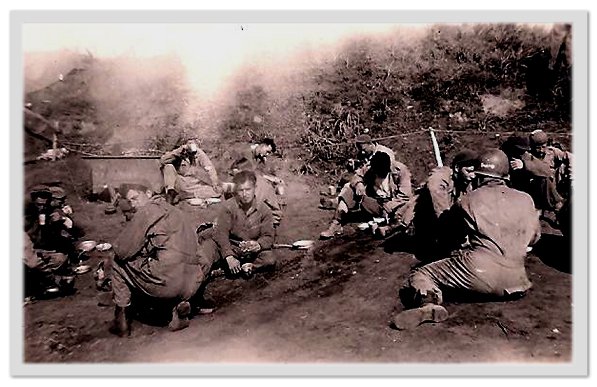
Anzio Chow Line, 1944
|
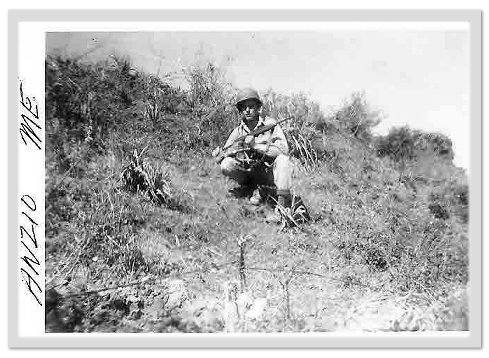
Gus Hazzard at Anzio, 1944
|
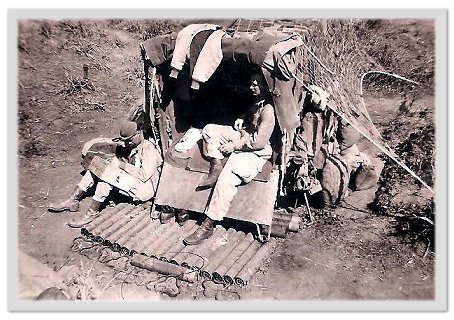
Gus Hazzard, in truck, and “Hambone (?)”
at Anzio
|
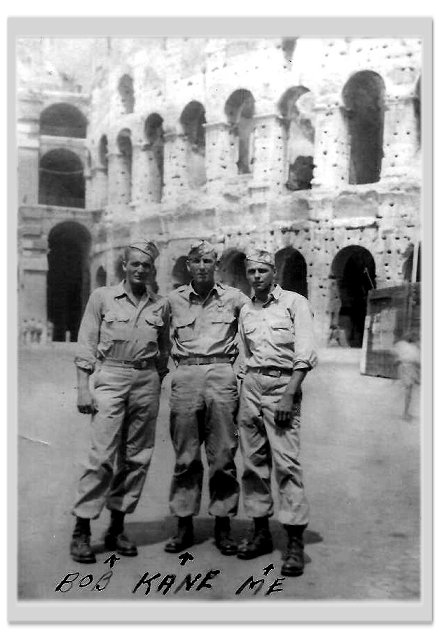
Bob Bolen, left, with Francis Kane
and Gus Hazzard, all “A” Battery, Rome, 1944 |
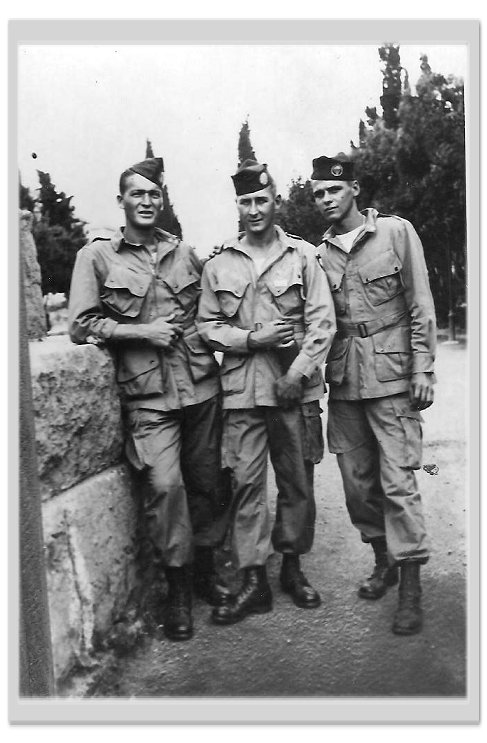
Also Bob Bolen, left, with Francis Kane
and Gus Hazzard in Rome, 1944 |
Award Recommendation
While in Mourmelon, France, in December 1944 prior to the Bastogne campaign, John Cooper recommended to higher authorities
that the 463rd be given a commendation for their performance in the Italian Campaign. This recommendation was not granted, but the
document he submitted does provide a great deal of historical information.
|
HEADQUARTERS
463rd Parachute Field Artillery Battalion
APO 464
U.S. ARMY
17 December 1944.
SUBJECT: Recommendation for Award.
TO : Commanding General, 101st Airborne
Division, APO 472,
U. S. Army
-
Under the provisions of War Department Circular
333, 22 December 1943, it is recommended that the 463rd
parachute Field Artillery Battalion be awarded
the Distinguished Service Badge.
- The 463rd Parachute Field Artillery Battalion
distinguished itself by extraordinary heroism in
action in the Italian Campaign as follows:
-
On 23 December 1943 this Battalion less
Batteries C and D, as the 456th parachute Field
Artillery Battalion, went into position near
Ceppagna, Italy, in support of the First Special
Service Force. Due to heavy snow and general
inclement weather, operations were static during
the period that this unit was on the Italian
southern front. Heavy artillery fire going in
both directions was the usual order of things.
On 30 January 1944, the Battalion, less
Batteries C and D, were withdrawn from the lines
and sent immediately to Naples, Italy where
LST's were awaiting to take them to the Anzio
beachhead. At 0800 hour 1 February 1944 they
were again in position and supporting the First
Special Service Force whose mission was to hold
the right flank of the beach-head on a line
generally coincident with the Mussolini Canal.
During the first days of the Battalions stay on
the beach-head the enemy made repeated efforts
to shove all the troops in the ten mile square,
back into the sea and create another situation
such as the English Armies experienced at
Dunkirk. These efforts were usually in the form
of a concentrated Infantry attack supported by
heavy artillery fire, and In one such barrage,
the battalion CP suffered a direct hit from an
enemy one hundred seventy (170) mm howitzer,
mortally wounding the Battalion 3-2, Assistant
S-2, and the communications officer and also
seriously wounding the Battalion Executive
officer and forcing his evacuation. A hasty
reorganization of the staff was accomplished in
spite of an officer shortage within the
Battalion by putting competent NCO's in
positions normally held by officers.
In the four day period, between 16 February 1944
and 19 February 1944, the night howitzers from
the two active firing batteries averaged over
one thousand two hundred rounds (1200) a day
against counterattacks which usually lasted
about an hour each, On 27 February 1944 the
battalion was officially credited with stopping
an attack on a seven hundred (700) yard front,
aimed at cutting the friendly lines and
recapturing the natural fortifications along the
canal, by firing one thousand three hundred
(1300) rounds in a little more than an hours
time. During this same four (4) day lapse of
time, Headquarters Battery and A Battery machine
gun sections were officially credited with one
enemy airplane each, after having remained by
their guns and continuing fire while the area
was being strafed.
On 16 February 1944, By General Order No. twenty
(20), Headquarters, Fifth Army, the 456th
parachute Field Artillery Battalion less
personnel and equipment, was transferred to the
European Theater of Operations. On the same
order the 463rd parachute Field Artillery
Battalion (less C and D Batteries) was organized
with the personnel and equipment of the 456th
parachute Field Artillery Battalion. At the same
time the Battalion was required to furnish a
cadre of six officers and sixty-one (61)
enlisted men, seriously effecting their fighting
strength. Replacements in part eased the
situation a bit, but for the rest of their
participation in the Italian Campaign, the 463rd
parachute Field Artillery Battalion never had
better than (80%) eighty percent of its Table of
Organization strength.
As the weeks progressed, less and less German
activity was noticed in the sector in which this
battalion was firing. It became necessary for
the forward observation parties to conduct their
own patrols in order to pick up targets and this
was done daily. On 1 March 1944 A Battery's
observer sighted a large enemy unit assembling
for an attack. Calling for fire, he completely
encircled the enemy by skillfully adjusting fire
and the entire group of one hundred sixty-seven
(167) men walked one thousand (1000) yards to
surrender. At this time, the group was the
largest ever taken together, in all of Italy. On
being questioned by Infantry intelligence
officers they stated that the artillery in this
sector was so terrible that they feared to move
at all, during the day. On numerous occasions
during the four month period, reconnaissance
officers of this unit, personally controlled
rolling barrages in front of the Infantry
attacks, by advancing with the Infantry scouts
and keeping the barrage in as close as possible,
often lose than one hundred (100) yards.
-
*** page 3 of this document is missing ***
... crawled to an
exposed position two hundred yards from the
target and destroyed it with his fire. He then
found his retreat cut off by another tank that
was holding up the surging Infantry and he
destroyed this one also. Again, the Battalion
was officially credited by the Infantry, of
opening the hole that let them through.
The next day, while on an advance
reconnaissance, the Battalion Commander was hit
and seriously wounded by German Artillery. His
evacuation was immediately ordered and the
Executive Officer assumed command. On 2 June the
assistant S-2, while on reconnaissance entered
the the town of Colle Ferro and contacted the
French forces advancing from the southern front.
This was the first contact made with the forces
moving from the south and information which was
exchanged proved very valuable and aided
materially in facilitating a rapid union of
troops.
Two days later, on a late evening reconnaissance
in front of the Infantry, which was dug in for
the night, the Battalion Commanders party was
forced to clear a house of enemy personnel, with
small arms fire before setting up a temporary
advance CP for an early morning attack. The same
night the gun Batteries quietly moved out in
front of the Infantry and into position as to be
able to deliver maximum direct and indirect fire
for the attack.
On 5 June 1944, the battalion was in position in
the suburbs of Rome. In order to deliver fire on
the Tiber River bridges, which was the only
escape route for enemy troops in Rome, it was
necessary to move two battery positions far to
the right flank. Suddenly a tank battle was
observed one thousand (1000) yards to the right
rear and the howitzers were turned three
thousand two hundred (3200) mils to fire in
support of the French coming up on the flank.
Fire was observed from the battalion CP. At the
same time, headquarters Battery turned in two
prisoners, captured in the Battalion area.
The next day, the Battalion was relieved. The
unit had been in the lines one hundred sixty-six
(166) days, and fired one hundred twenty
thousand (120,000) rounds of ammunition. In the
last fourteen days, the unit changed position
eleven times; on two occasions three different
positions were occupied in one day, Special unit
commendations were received from General MARK W.
CLARK, Fifth Army Commander, General ROBERT T.
FREDERICK, First Special Service Force Commander
and Colonel THOMAS E. de SHAZO, VI Field
Artillery Group Commander.
-
Among other missions, the Battalion has either
destroyed or neutralized, the following targets
while in Italy; forty-one (41) houses, one
hundred eleven (111) enemy gun positions,
twenty-seven (27) command posts, twenty-four
(24) mortars, forty-six (46) machine guns,
forty-six (46) enemy observation posts,
thirty-nine (39) self propelled guns, one
hundred eleven (111) pill boxes, forty-four (44)
tanks, twenty-six (26) vehicles, thirteen (13)
ammunition dumps. Over four hundred (400)
personnel targets were fired on.
-
The Battalion has fired approximately one
hundred twenty thousand (120,000) rounds of
ammunition and approximately four thousand
(4000) call fire missions.
Officers Enlisted Men
Missing in action - - - - - 0
1
Non-battle Casualties - - - 0
2
Wounded - - - - - - - - - - 10
38
Killed - - - - - - - - - - 3
1
Died of wounds - - - - - - 0
1
-
PROPOSED CITATION:
The 463rd parachute Field Artillery Battalion
fought for one hundred sixty-six (166) days in
Italy, on two of the bloodiest fronts of the war and
in one of the most fiercely fought pushes to date,
Casino, Anzio, and the drive to Rome. During this
six month period the Battalion was at all times
under strength and yet they asked for and received
four extra howitzers, just before pushing off to
Rome, in order to increase their fire-power. All
available personnel were used on the gun crews. At
Anzio, the men were forced to live for months in a
drainage ditch. To step out of the ditch meant
certain enemy artillery fire, because the enemy
commanded all of the heights. There were two and
three air raids nightly and at least twice a week
the Battalion motor pool was shelled. The unit lost
one Battalion Commander, one Battalion Executive
officer, two Battalion Communications officers, two
air observers, one S-2, one assistant S-2 and one
assistant S-3, from the Staff during this period.
Vacancies were filled from available personnel,
however, as fast as they occurred and at no time was
the efficiency of the organization seriously
impaired. Seven (7) large scale counter attacks were
repulsed by fire from this battalion. A flash base
was set up by the Battalion survey section in lieu
of a flash observation group for the sector,
operated nightly with excellent counter battery
results. On the push to Rome, all personnel worked
overtime to assure the success of the Battalions
function as Division Artillery. Forward
displacements were made right along with or in front
of Infantry assault companies. Battalion officers
flying in the liaison planes often scouted ahead for
advancing friendly tank columns, sometimes flying
sixteen (16) hours a day. Tremendous preparation
barrages, and accurate call fires by the Battalion
made possible the initial breakthrough from the
Anzio beach-head on the push to Rome, the second
breakthrough at Artena, and the union of French
troops and American troops at Colle Ferro.
JOHN T. COOPER, JR.,
Lieutenant Colonel, Field Artillery,
Commanding.
|
Commendations General CLARK and General
FREDERICK
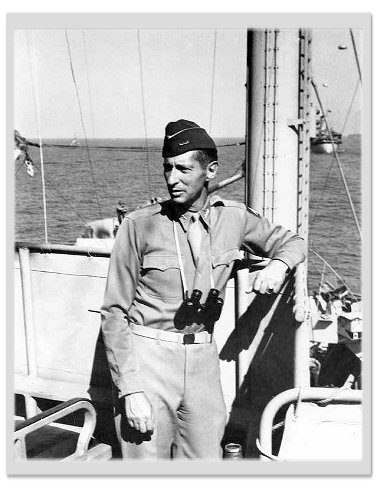 |
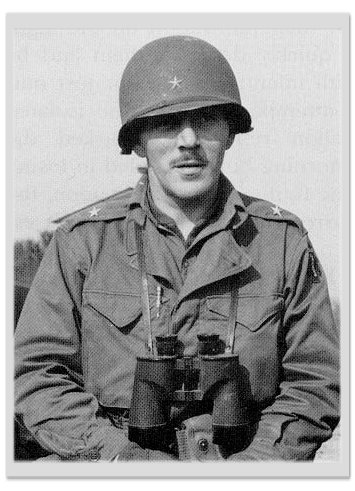 |
|
Photo #: 80-G-87335
Lieutenant General Mark W. Clark, U.S. Army,
Commanding General, Fifth Army
(On board USS Ancon (AGC-4)
during the landings
at Salerno, Italy, 12 September 1943.
Official U.S. Navy Photograph,
now
in the collections of the National Archives.)
|
Robert T. Frederick
as a brigadier general |
General CLARK
|
HEADQUARTERS FIFTH ARMY
Office of the Commanding General
A. P. O. 464, U. S. Army
5 July 1944
SUBJECT: Letter of Farewell.
TO : Commanding Officer, 463rd
Parachute Field
Artillery Battalion, A. P. 0.
472, U. S. Army.
1. It is with
sincere regret that I see the 463rd Parachute Field
Artillery Battalion leave the fold of Fifth Army. You leave
us with an enviable record of achievements and with the high
esteem of the infantry units which you supported so
vigorously and effectively.
2. The field artillery has played a most important role in
the entire Italian campaign and a spectacular one in the
recent great offensive which you are now walled upon to
leave its completion. We have had ample confirmation of this
from German prisoners as well as from our own infantry.
3. I am well aware of the difficulties and hardships which
you have had to overcome in order to achieve these
outstanding results. However, regardless of the mountainous
terrain, scarcity of roads, long supply lines and a
constantly changing tactical situation, you have done a
superb job in accordance with the highest traditions of the
artillery. 4. At this
time I wish to congratulate you for the task performed and
extend my heartfelt good wishes for further successes in the
new assignments which you are about to undertake. With my
renewed thanks for your help and splendid cooperation, I am
Sincerely yours,
s/Mark W. Clark
MARK W. CLARK
Lieutenant General, U.S.Army
Commanding CERTIFIED TRUE COPY:
LESTER S. KLEIN
Capt., Field Artillery
Adjutant
|
General FREDERICK
|
HEADQUARTERS, FIRST SPECIAL SERVICE FORCE
ATO 4994, U. S. Army
22 June 1944 SUBJECT: Commendation. TO
: Commanding Officer, 463rd Parachute Field Artillery
Battalion, APO 464, U. S. Army.
1. I wish to express to the officers and men of the 463rd
Parachute Field Artillery Battalion my appreciation for the
manner in which they performed their missions during the
recent operations prior to the occupation of Rome.
2. The aggressive willing spirit displayed in the execution
of all assigned missions was gratifying and a tribute to
your organization. The speed and exactness with which all
orders were carried out were important factors in the
excellent artillery support your unit provided. Your
missions were difficult and placed unusual demands upon the
battalion, but each was accomplished in a superior manner.
s/Robert T. Frederick,
ROBERT T. FREDERICK
Brigadier General, U. S. Army
Commanding CERTIFIED TRUE COPY:
LESTER S. KLEIN
Capt., Field Artillery
Adjutant.
|
MONTHLY NARRATIVES
February 1944
|
HEADQUARTERS
463rd Parachute Field Artillery Battalion
A.P.O. 464,
U.S. Army
14
March 1944
HISTORICAL NARRATIVE 463RD PARACHUTE FIELD
ARTILLERY BATTALION
A.P.O. 464, C/O POSTMASTER, NEW YORK, NEW YORK: PERIOD 20
FEB-
RUARY 1944 TO 29 FEBRUARY 1944.
At 1201 hr., by General
Order No. 20, Fifth Army, Dated 16 February 1944, the
456th Parachute Field Artillery Battalion was
transferred from the North African Theater of Operations
to the European Theater of Operations, less equipment
and personnel. At the same time the 463rd Parachute
Field Artillery Battalion (Less Batteries C & D), was
activated with the personnel and equipment left in this
Theater by the 456th Parachute Field Artillery
Battalion.
The 463rd began its new
life under the command of Hugh A. NEAL, 0-243381, MAJOR,
F.A. This activation, which was made with all units on
the battle front, was carried out as per orders without
a great deal of confusion, due to the Commanding
Officer's ability and determination to keep the
Battalion firing under any circumstance.
During the time of the
transfer and activation, the Battalion was called upon
to furnish a Cadre of six (6) Officers and Sixty-one
(61) enlisted men. It appeared that the Battalion was to
be reduced to an effective Officer strength of twelve
(12) Officers, but replacement of three (3) Officers
and sixty-one (61) enlisted men arrived the day the
Cadre departed.
The Battalion, from 1200
hours the 19th of February, to 1200hours the 21st day of
February, fired through eight guns, a total of 1684
rounds, which in itself indicated the ability to deliver
fire regardless of activation and Cadre troubles.
Exceptionally good work has
been done by Forward Observers and Air Observers during
this period. One German Counter-Attack, during the early
morning hours 26 - 27 February, was handled very well by
1ST LT. ALFRED J. MURY, 0-1169265, and 1ST LT. ORVAL H.
SHEPPARD, 0-1166604, firing a total of 1782 rounds.
Numerous Enemy Personnel were reported destroyed as well
as two tanks being disabled by direct hits. one. Enemy
gun battery was neutralized and three self-propelled
guns were forced to withdraw because of the intensity of
our Artillery fire.
2ND LT. James K.
Rozen,0-1173061, Air Observer, has registered the
Battalion each morning and has accounted for six
vehicles, neutralized two gun batteries, as well as
brought fire on many troop and machine gun nests during
this period.
For this period, this
Battalion has expended 6657 rounds of Ammunition and
destroyed, or disabled, at least seven tanks, nine self
propelled guns, and neutralized three gun batteries, not
to mention numerous vehicles, machine gun emplacements,
and enemy personnel destroyed.
JOHN T. COOPER, JR.
Major, 463rd Prcht. F. A. Bn.
|
March 1944
|
HEADQUARTERS
463rd Parachute Field Artillery Battalion
A.P.O. 464, U.S. Army
HISTORICAL NARRATIVE, 463rd Parachute Field
Artillery Battalion
From 29 February 1944, to 31 March 1944
The 463rd Parachute Field
Artillery Battalion was in general support of FSSF
during this month. All installations are in the same
locations as previous month. Infantry installations
have not changed. In the early part of the month, many
personnel targets were found, but later, the enemy
circulation became very limited. Enemy tanks and guns
were not noticeable in the latter part of the month.
This Battalion fired
approximately 13,000 rounds of ammunition on targets as
follows, using ground and air Op's:
Personnel ........... 149
Guns ................ 33
Tank ................ 18
Targets disabled or
destroyed, include three (3) tanks and five (5)
vehicles. Destroyed, were four (4) mortars, ten (10)
dugouts, two (2) pill boxes, and seven (7) gun
positions, all by observed fire. The results obtained
throughout were excellent.
The Battalion flash set-up
reported to Corps, some eighteen (18) locations that
were beyond our range, together with about twenty
(2)locations fired on by the Battalion.
Ammunition allowance was
cut drastically during the month.
On March 26sth, four (4) additional
howitzers were obtained. The Battalion now
operates with two (2) six-howitzer batteries.
During the early part of
this month, barbed wire was placed across natural
approaches, in event of enemy attack, and machine guns
placed to insure coverage of the wire.
Camouflage, cover, drainage
of area was continually checked and improved.
Circulation was limited, and vehicles came into the area
only at night.
Excellent work by officers
and enlisted men of the forward observation details
continues.
HUGH A. NEAL
Major, 463rd Prcht. F.A. Bn.
Commanding
|
April 1944
|
HEADQUARTERS
463rd Parachute Field Artillery Battalion
A.P.O. #464
U.S. Army
HISTORICAL NARRATIVE, 463rd Parachute
Field
Artillery Battalion
From 1 April 1944 to 30 April 1944
The 463rd Parachute Field Artillery Battalion
was in general support of First Special Service Force during
the month. All installations are in the same location as
previous month. Infantry installations have not changed,
although several raids in force were successfully made.
This Battalion fired approximately 13,270
rounds of ammunition on the targets as follows, using ground
and air O.P.’s:
Personnel
-108
Guns, Mortar and MG -
10
Tanks, SP
- 11
Vehicles
- 10
Targets disabled, destroyed, or neutralized include eight
(8) tanks, three (3) SP, three (3) machine guns, two (2)
mortars, one (1) dugout and four (4) gun positions, all by
observed fire. The results obtained throughout were
excellent.
The Battalion flash section reported
forty-six (46) locations, nine (9), of which were fired upon
by the Battalion, and thirty-one (31) fired upon by
supporting artillery. Large fires were observed after
concentrations were fired on three (3) occasions. One large
fire burned for one and one-half (1 1/2) hours. Flames
appeared to reach two hundred and fifty to three hundred
feet (250 to 300).
During two(2) air raids, bombs landed within
the Battalion area. Personnel bombs released on the night of
20 April, wounded one (1)man. On the night of 30 April one
incendiary bomb fell within the area, but no damage or
casualties resulted.
Camouflage, cover and drainage of area were
continuously checked and improved. Circulation was limited,
and vehicles come into area only at night.
Exce1lent work by officers and enlisted men
of the forward observer details continued.
For the Battalion Commander:
John T. Cooper, Jr.,
Major, F.A..
Adjutant
|
May 1944
|
HEADQUARTERS
463rd Parachute Field Artillery Battalion
APO #464, U.S. Army
13 June 1944
HISTORICAL NARRATIVE, 463rd Parachute Field
Artillery Battalion
From 1 May 1944, to 31 May 1944
At the beginning of the month the 463rd
Parachute Field Artillery Battalion was firing in general
support of the First Special Service Force. On 4 May 1944,
the 3rd Provisional Pack Battery was attached for
operational control and closed in firing position. Support
of the First Special Service Force was continued until 9 May
1944 at which time Battalion went into general support of
the 36th Engineer Combat Regiment.
The Cannon Platoon, First Special Service
Force, was attached to this Battalion and closed in firing
position 10 May 1944, and remained as such until 16 May 1944
at which time it reverted to First Special Service Force. On
20 May 1944 this Battalion was assigned the mission of
reinforcing of the 156th Field Regiment, R.A. On 21 May 1944
this Battalion was relieved of this mission and placed in
direct support of the First Special Force and at this time
the 155th Field Artillery Battalion.
The 131st Field Artillery Battalion and the
151st Field Artillery Battalion were assigned the mission of
reinforcing the fires. Also on this date a displacement was
made from the position (overlay A) to another position
(overlay B). At approximately 2000 hour 23 May 1944, this
Battalion with the 155th Field Artillery Battalion
reinforcing was assigned the mission of reinforcing the
fires of the 151st Field Artillery Battalion which was
firing in direct support of the 133rd Infantry.
On 24 May 1944 this Battalion resumed the
mission of direct support of First Special Service Force
with the 155th Field Artillery Battalion and the 938th Field
Artillery Battalion reinforcing the fires. With the
situation moving rapidly, this Battalion found it necessary
to displace from its position (overlay B) first to the
position (overlay C) on 24 May 1944, and to two other
positions (overlays D and E) on 25 May 1944.
At this time the 155th Field Artillery
Battalion and 938th Field Artillery Battalion relieved from
reinforcing fires and the 39th Field Artillery Battalion
placed in general support of this Battalion. On 27 May 1944,
this Battalion went into position in the vicinity of Colle
Tafo, Italy (overlay F) where it remained until the close of
the month.
Throughout this monthly period, this
Battalion fired a total of approximately 41,245 rounds of
ammunition on targets as follows, using ground and air OP's:
-1- |
|
Historical Narrative, Hq 463rd Prcht FA Bn,
continued:
Personnel - - - - - - - - - - - - - - 70
Tanks and SP’s - - - - - - - - - - - - 23
Vehicles - - - - - - - - - - - - - - - 7
Guns, Mortars, and M.G. - - - - - - - 47
Ammunition dump - - - - - - - - - - - 1
Observation Posts - - - - - - - - - - 21
Targets disabled, destroyed or neutralized
include sixteen (16) tanks, seven (7) self-propelled guns,
fourteen (14) machine guns, five (5) mortars, twenty-eight
(28) gun positions, all observed fire. On six (6) occasions
this Battalion fired six (6) preparations fires and from
defensive overlays, defensive fires were fired fives (5)
times. This Battalion assisted in breaking one counterattack
which occurred at about 2400 hour 29 May 1944, at which time
2121 rounds were fired.
The casualties for this Battalion for the
month of May includes one (1) Enlisted Man killed, three (3)
Officers and six (6) Enlisted Men wounded. Included in this
list was the Battalion Commander who was wounded and
evacuated on 31 May 1944.
One (1) Officer and two (2) Enlisted Men of
this Battalion were decorated during this period. The Bronze
Star Medal was awarded to S/Sgt Robert J. Donahue and Pvt
Raymond Rogers of Battery “A” for heroic achievement in
action in Italy. 1st Lieut. Rozen the air observer for this
Battalion received two (2) Bronze Oak Leaf Clusters for the
completion of seventy (70) Field Artillery Observation
sorties. Attached hereto are the summaries of each of these
citations.
The morale of this Battalion for the month
was excellent and excellent work by the Forward Observer
details and communication sections was continued.
For the Battalion Commander:
STUART M. SEATON
Captain, F.A.,
Adjutant
1 Incl.
Incl. #1 – Citations of 1st Lieut. Rozen and S/Sgt Donahue
and Pvt. Rogers.
|
CITATION OF 1ST LIEUTENANT JAMES K. ROZEN:
Under the provisions of Army regulations
600-45, as amended, you are awarded the first and second
Bronze Oak Leaf clusters to the Air Medal for meritorious
achievement while participating in aerial flight.
CITATION:
“JAMES K. ROZEN, (01173961). First
Lieutenant, Field Artillery, United States Army, For
meritorious achievement while participating in aerial
flight, by performing seventy Field Artillery observation
sorties against the enemy in Italy, during the period 27
February 1944 to 11 April 1944. Entered military service
from Mason City, Iowa.”
CITATION OF STAFF SERGEANT DONAHUE AND PRIVATE ROGERS:
ROBERT J. DONAHUE, 20234843, Staff Sergeant
Battery “A”, Parachute Field Artillery Battalion,
Entered military service from Bloomfield, New Jersey.
RAYMOND R. ROGERS, 20119912, Private
Battery “A”, Parachute Field Artillery Battalion
Entered military service from Marston Mills,
Massachusetts.
For heroic achievement in action in Italy on
27 February 1944. During an enemy artillery preparation,
which preceded an attack, Staff Sergeant DONAHUE and Private
ROGERS crawled 500 yards through constant enemy artillery
shelling to repair the communication lines. The prompt
action of Staff Sergeant DONAHUE and Private ROGERS in
repairing the telephone lines allowed the Artillery to repel
the enemy attack. The heroic achievement of these men
reflects great credit upon themselves and the military
service. |
June 1944
|
HEADQUARTERS
463rd Parachute Field Artillery Battalion
A.P.O. 464, U.S. Army
HISTORICAL NARRATIVE, 463rd PARACHUTE FIELD
ARTILLERY BATTALION
From 1 June 1944, to 6 June 1944
6 July 1944
Throughout this period from 1 June 1944 to 6
June 1944 inclusive the 463rd Parachute Field Artillery
Battalion was attached to the 6th Armored Field Artillery
Group and firing in direct support of the First Special
.Service Force. This Battalion fired a total of 1907 rounds
during this period of which the greatest portion was fired
on preparation. On 1 June 1944 this Battalion was in
position as indicated on overlay "A", from which a
displacement was made to another position (Overlay "B") on 3
June 1944. On 4 June 1944 displacement was made again to the
next position (Overlay "C") from which the final
displacement was made to a new position (Overlay "D") on 5
June 1944. This Battalion remained in this position until 6
June 1944 at which time it was relieved from attachment to
the 6th Armored Field Artillery Group and was placed in
Fifth Army Reserve as of 0600 hours that date.
There were no battle casualties and the
morale of this Battalion for this period was excellent.
For the Battalion Commander:
STUART M.
SEATON
Captain, F.A.,
Adjutant.
|
40th Anniversary of
the Commemoration of the Liberation of Rome, Rome, June 4, 1984.
The Sicily-Rome American Cemetery and Memorial lies immediately
east of Anzio and about 38 miles south of Rome. Gus visited there
in 1984 in conjunction with veterans of units participating in the
40th anniversary Commemoration of the Liberation of Rome on June 4,
1944, including the First Special Service Force, the 463rd Parachute
Field Artillery Battalion and others. The FSSF plaque in Rome, that
also names the 463rd, was placed in Piazzale Ostiense, on the side
of Viale del Campo Boario. It hangs on Aurelian Walls next to
Pyramid of Cestius and reads as follows:
FIRST
SPECIAL SERVICE FORCE
IN MEMORIAM
ON 4 JUNE 1944
THE UNITED STATES-CANADIAN
FIRST SPECIAL SERVICE FORCE
COMMANDED BY
BRIGADIER GENERAL ROBERT T. FREDERICK
LED ALLIED FORCES OF
GENERAL MARK CLARK'S
FIFTH ARMY. A PART OF
FIELD MARSHAL SIR HAROLD ALEXANDER'S
FIFTEENTH ARMY GROUP, IN THE ATTACK
TO LIBERATE THE ETERNAL CITY.
IN THIS ACTION TASK FORCE HOWZE OF THE
1ST ARMORED DIVISION, THE 463D PARACHUTE
FIELD ARTILLERY AND CITY UNITS OF THE
ITALIAN RESISTANCE GAVE VALIANT SUPPORT
AS WE BREACHED THE GATES OF ROME
AND SECURED THE TIBER BRIDGES.
TO OUR BROTHERS IN ARMS
OF ALL NATIONS WHO DIED IN THE
BATTLES OF THE ITALIAN CAMPAIGN
WE DEDICATE THIS MEMORIAL.
FIRST SPECIAL SERVICE FORCE
ASSOCIATION
4 JUNE 1984
MONTE LA DEFENSA • MONTE MAIO • MONTE SAMMUCRO
ANZIO BEACHHEAD • ROME
Photos below were taken by
Gus Hazzard in June 1984 when veterans of the 463rd PFA
and First Special Service Force were in Italy for the Commemoration
of the Liberation of Rome.
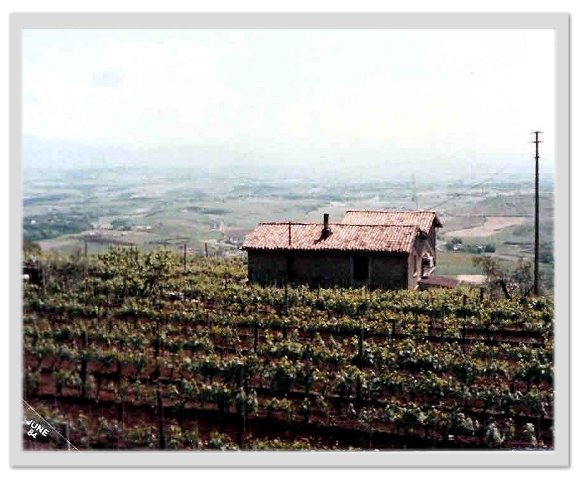
Looking down from Artena in 1984
at site of 463rd
OP in 1944
|
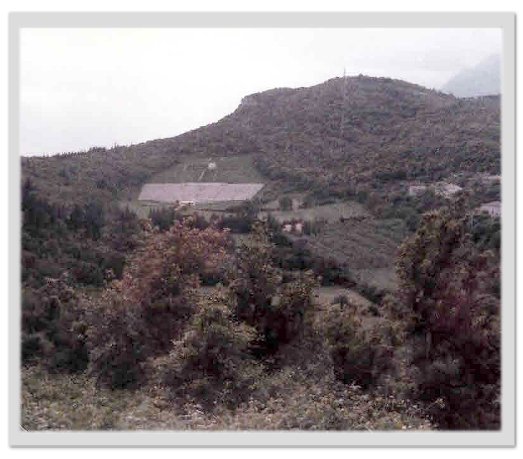
View of the adjacent valley
from Artena, Italy, 1984
|
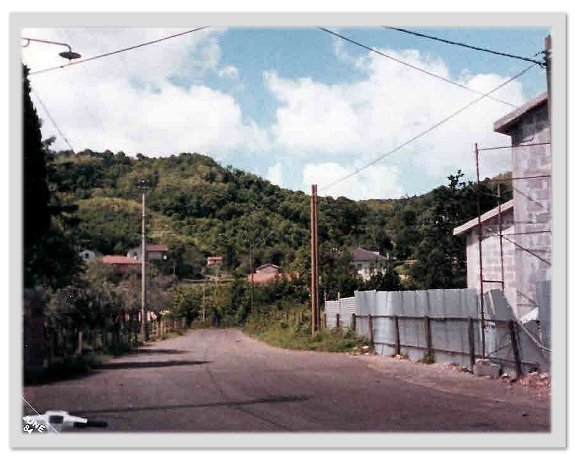
Road into Artena, Italy
|
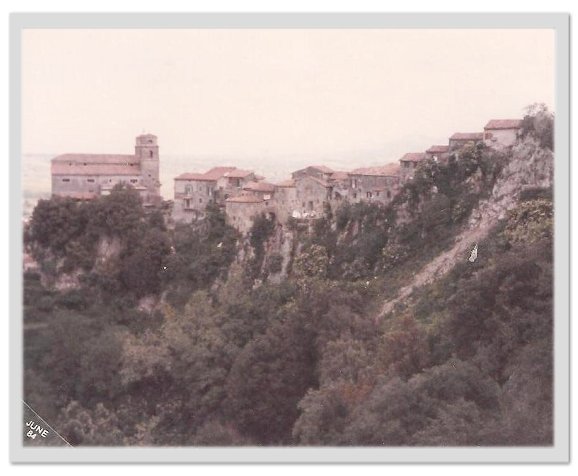
1984 view of Artena seen by 463rd PFA
and First Special Service Force in 1944
|
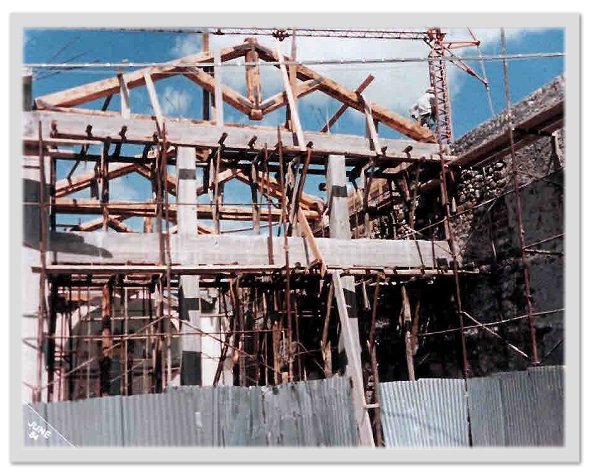
Artena, Italy, church in which 463rd troops were
“holed up” in 1944,
under re-construction 1984
|
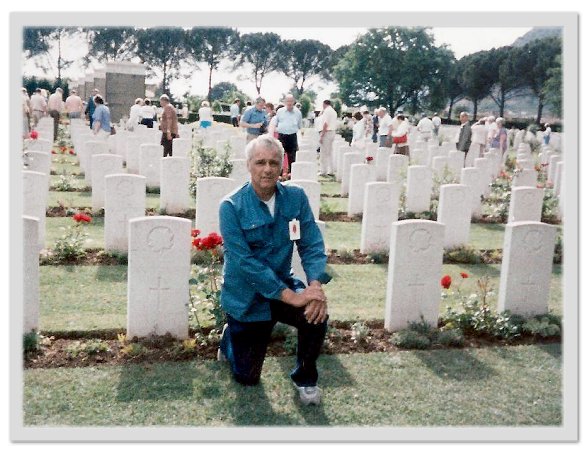
Gus Hazzard visits the Sicily-Rome American Cemetery near
Anzio June 1984
for the commemoration of the 40th Anniversary of
the Liberation of Rome
|
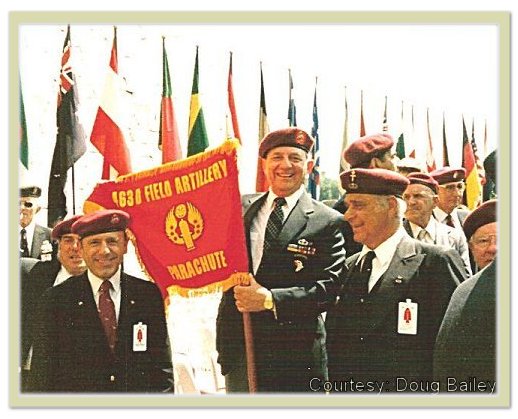
Jay Karp, holding the 463rd banner, center, at the 1984
Commemoration of the Liberation of Rome.
Gus Hazzard is to his left, with Col. John Cooper, 463rd
commander, barely visible wearing a beret at far right.
|

|









